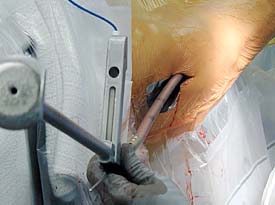Internal fixation: an evolutionary innovation for fracture care
Wires, plates, screws and nails all have a role in this dramatic story.
![Innovations in Orthopedics [icon]](/~/media/images/news/print/orthopedics-today/2005/10_october/innovations_375_60_4059.jpg) In a survey of its membership, the American Academy of Orthopaedic Surgeons has found that a large number of orthopedists ranked the development of internal fixation for fractures as one of the most significant advances in treatment during the 20th century.
In a survey of its membership, the American Academy of Orthopaedic Surgeons has found that a large number of orthopedists ranked the development of internal fixation for fractures as one of the most significant advances in treatment during the 20th century.
Reports on the use of internal fixation go back in the literature more than 100 years, when surgeons stabilized broken bones with wires. As surgery progressed into the antiseptic era, the use of intramedullary nails, screws and plates spread globally. Orthopedic pioneers such as Hey-Groves, Danis, Smith-Petersen and Küntscher advocated and advanced the use of internal fixation, even though the conventional wisdom of the orthopedic community at that time may have been against them.
Hidden by war
Küntscher was one of the first to have success with intramedullary (IM) nails. Although he began working with IM nails shortly before the outbreak of World War II, he kept his findings secret from the non-German world until after the war had ended. In fact, some of the first Küntscher nails that were seen in the United States were in the femurs of former prisoners of war. The lack of suitable imaging equipment and prejudice against the technique basically kept the device out of the hands of American orthopedists until the 1980s.
With the development of C-arm radiography in the late 1970s, surgeons had the opportunity to visualize the reduction and insertion of the nails and, hence, match Küntscher’s results.
“In 1983, in most every hospital in the U.S. there were wards of patients in traction for femur fractures,” said Thomas A. “Toney” Russell, MD, of Memphis, Tenn. “In our center we would usually have 50 to 70 people in traction for approximately six to 12 weeks. Then they would go into a body cast with a 20% nonunion rate; all had a residual deformity. If you had a comminuted fracture, you had a problem for the rest of your life,” said Russell, a professor of orthopedic surgery at University of Tennessee Health Science Center, College of Medicine.
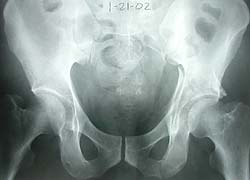 |
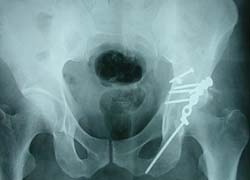 |
These radiographs show an acetabular fracture preoperatively (left) and postoperatively (right). Courtesy of Joel Matta | |
Most dramatic story
A 1984 publication in the Journal of Bone and Joint Surgery by Robert Winquist, MD, Sigvard Hansen Jr., MD, and D. Kay Clawson, MD, of 500 cases treated with closed IM nailing set the technique on the road to credibility in the United States. “They had a 99% union rate,” Russell said. “That was the best union rate published up to that point in the literature.” However, the orthopedic community of the time was not open to the concept. “I was at meetings where they called them liars,” he said. “Those guys really carried the banner and took the hits.”
Later that year, Johnson, Johnston and Parker published a comparative study of roller traction, IM nailing with cerclage wiring and interlocking IM nailing. Even though the study was small, less than 100 patients, the results were impressive. Overall, the failure rate with roller traction was 66%, 39% for the IM nails with the cerclage wiring and 4% for the interlocking nails.
“It was so extraordinary having those two papers within a year,” Russell said. “Within 18 months from 1984, you almost never even saw a traction ward in the United States. For me it is one of the most dramatic stories in medicine and outside of orthopedic trauma, people don’t even know about it.”
Nailing developments
Over the years there have been many variations of the IM nailing concept including the Klemm-Schellmann, Modney and Huckstep locking nails, Rush and Ender’s use of intramedullary tensioning, and Lieger’s elastic stable intramedullary nails.
Russell along with colleague John Charles Taylor, MD, designed and built the Russell-Taylor interlocking nail in 1984. It is currently in its third generation as the TriGen System (Smith & Nephew) and soon will be introduced in its fourth generation, which will allow the nail to be used as a carrier for biologic agents and will contain a telemetry system. “They will be able to tell you if the fracture is healing or not,” Russell said. “It will even tell you if the patient is walking or not.”
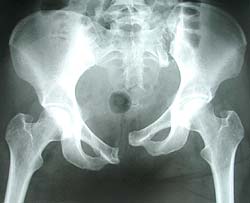 |
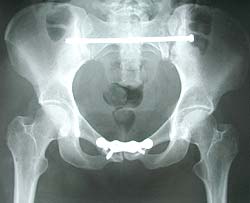 |
This pelvic fracture (left) was treated with an Intra Medullary nail (right). Courtesy of Joel Matta | |
Reduction importance
Fractures of the pelvis and acetabulum require different forms of internal fixation, but it is not the hardware that is important. “When you talk about internal fixation, the main purpose of operating is to reduce the fracture,” said Joel M. Matta, MD, the John C. Wilson, Jr., chair of orthopedics at Good Samaritan Hospital in Los Angeles. “Sometimes surgeons forget that. They operate to fix the fracture, but the plates and screws do not help the patient. The reduction is the important part.”
Matta, who is one of the most peer-review published investigators of acetabular and pelvic fractures, said the biggest step in operatively treating these fractures is understanding the X-rays and fracture patterns presented. “The understanding we get from the X-rays allows us to interpret the fracture pattern and access the proper surgical approach. This opened the way for us to be able to perform an accurate reduction, as well as the internal fixation of the fracture.”
Table matters
As director of The Emile Letournel Institute, Matta has led the Fractures of the Acetabulum and Pelvis course in Paris and Los Angeles since 1994. He said that maybe even more important than the internal fixation, having a good orthopedic table is paramount for a successful reduction. “The internal fixation with plates and screws has not been particularly innovative over the past 20 years,” he said. “One of the important technical parts of the procedure that has been taught from the beginning is the use of an orthopedic table for doing the acetabular and pelvic surgery called the Judet table. It was an important aid in the reduction of acetabular and pelvic fractures and it allowed the surgeon to limit the surgical approach.”
Matta said when he started studying the techniques of open reduction and internal fixation for pelvis and acetabular fractures that were being practiced in Europe, his American colleagues were unsure. “They thought that I was crazy trying to operate on these types of fractures. They said that I was just going to get horrible complications, and that there was no way that I could improve the results. Over the coming years the thinking kind of changed. People have come around to the idea.”
Minimally invasive
Courtesy of Toney Russell |
He said that manufacturers stopped making the Judet tables in the 1980s and so he designed his own. His Profx table has the advantages of the Judet, plus it allows for closed reductions and percutaneous fixations for pelvic fractures. “There are groups that advocate the closed reduction and percutaneous fixation of acetabular fractures, however, the acetabulum is a joint so you need a very accurate reduction,” he said. “When we operate on the acetabulum we are trying to get reduction within 1 mm, any more than that can result in a higher incidence of arthritis. I don’t think the current technology allows us to get the acetabulum reduced well enough to make closed reduction and percutaneous fixation widely applicable.”
Plates and screws
The story of the evolution of internal fixation would not be complete without discussing the achievements of the Arbeitsgemeinschaft für Osteosynthesefragen (AO) group of Switzerland. After observing and assisting in many surgeries with his mentor Danis in Brussels in the 1950s, Prof. Maurice M. Müller saw the advantages and disadvantages of the internal fixation. In a 2001 interview, Müller told Orthopedics Today, “After I came back from a visit to Vienna where I saw Böhler’s clinic and technique, I thought if Böhler can do a very big school for the conservative treatment of fractures, we should be able to make an international school for the treatment of fractures by the means of internal fixation.”
And thus he did. With a handful of like-minded friends he founded the AO to conduct research into bone healing with particular interest in anatomic reductions, stable internal fixation, blood conservation and early mobilization.
Soon the AO had formed an alliance with a Swiss stainless steel manufacturer to produce the specialized instruments and implants required for its techniques. In 1960 the group began its instructional courses and international attention soon followed.
The big story
“When I first came to the U.S. to talk about my discovery, there were only 20 people in the audience, but Stinchfield told many people that this was going to be an extraordinary presentation and that they would see things that were never had seen or heard here,” Müller said. “Suddenly many, many people came in. After 20 minutes it was standing room only and people were all over. That was the beginning of the big story and from that moment we have had Americans in Switzerland to learn.”

